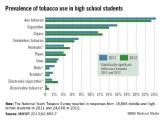Students in grades 6-12 who have never smoked traditional cigarettes are trying e-cigarettes in greater numbers, potentially justifying the Food and Drug Administration’s proposal to broaden its tobacco oversight to include e-cigarettes.
The number of middle- to high-school-aged children who have never smoked but have used e-cigarettes increased threefold between 2011 and 2013 from 79,000 to 263,000, based on an analysis of the Centers for Disease Control and Prevention’s (CDC’s) National Youth Tobacco Survey from 2011, 2012, and 2013. In addition, among those who have tried e-cigarettes, 43.9% said they intended to smoke conventional cigarettes, according to a report published online Aug. 20 in Nicotine & Tobacco Research.
"The increasing number of young people who use e-cigarettes should be a concern for parents and the public health community, especially since youth e-cigarette users were nearly twice as likely to have intentions to smoke conventional cigarettes, compared with youth who never tried e-cigarettes," Rebecca Bunnell, Sc.D., associate director of the CDC’s Office on Smoking and Health, and her colleagues reported (Nicotine Tob. Res. 2014 Aug. 20 [doi: 10.1093/ntr/ntu166]).
Research also found connections between the number of tobacco ads to which youths were exposed and the likelihood of intention to smoke cigarettes. Of students who said they had no exposure to such advertising, 13% reported that they intended to smoke, compared with 20.4% of those who reported exposure to one or two ads and 25.6% among those reporting exposure to three or four ads.
The Food and Drug Administration currently is reviewing comments on a proposed rule that would broaden its regulatory authority over tobacco products to include e-cigarettes. Various medical societies have called for that regulation to cover advertising of e-cigarettes as well as other related products, such as refill containers.
The authors reported no conflicts of interest.
gtwachtman@frontlinemedcom.com
